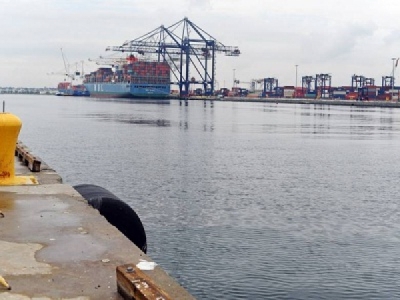
Posted on September 6, 2016
By Scott Fallon, NorthJersey.com
When the last bit of sediment of was hauled out of New Jersey waters this summer to deepen navigation channels, it ended a nearly three-decade project that saw enough dredged river mud and bedrock to fill MetLife Stadium 24 times.
Lawmakers on Thursday joined the U.S. Army Corps of Engineers and Port Authority officials in marking the completion of the $2.1 billion project that allows some of the largest cargo ships to reach the region’s ports.
The ceremony was the culmination of a project that began in 1989 and, after a five-year delay in the 1990s, became one of the largest infrastructure projects in the region’s history. It deepened 38 miles of channels to 50 feet beginning south of the Verrazano Narrows Bridge and winding its way in the waters between New Jersey and Staten Island to allow massive container ships access to Port Newark/Port Elizabeth.
The project was essential to maintaining the region’s four major ports, particularly now that the Panama Canal has been widened, allowing super-sized ships to carry cargo back and forth between New Jersey and Asia.
Deepening the channels was “the most important and influential project related to modern day economics in the Northeast,” said Col. David Caldwell, the Corps of Engineers’ district commander.
The waters around New York Harbor are heavily polluted from decades of industrial waste. Environmentalists had raised concerns more than a decade ago that the dredging could stir up toxic chemicals like cancer-causing dioxin from a Newark chemical plant or PCBs dumped in the Hudson River by General Electric Co.
But Corps of Engineers officials said Thursday they were able to confine the contaminated sediment to make sure it didn’t migrate across the region’s waterways. They also said they were able to use the majority of contaminated sediment to help cap 12 landfills, including some in the Meadowlands along with former industrial sites like the current IKEA shopping complex off the New Jersey Turnpike in Elizabeth.
The contaminated sediment was often mixed with cement to cap New Jersey landfills, said Bryce Wisemiller, the project manager for the corps.
Meadowlands officials, who oversaw the $150 million capping of several major landfills in recent years, have said the sediment was cleaned to a residential standard under the supervision of the Corps of Engineers before it was dumped on the landfills.
“Most of the material was far below hazardous-waste levels,” Wisemiller said. “But it is contaminated enough that you have to manage how and where it is placed. New Jersey came with a like-on-like placement approach. Something like arsenic would be taken to sites like a landfill that was already contaminated with arsenic.”
Debbie Mans, executive director of the advocacy group NY/NJ Baykeeper, said the project had its flaws but it ultimately is good for the long-term health of the waterways.
“You’re getting a lot of contaminated sediment out of there and that’s definitely going to be better for the area in the long run,” she said.
Clean material, such as bedrock, was used to build artificial reefs off the Jersey Shore and New York beaches.
Sen. Bob Menendez, a Democrat, and U.S. Rep. Rodney Frelinghuysen, a Republican, were credited with getting funding for the project after it had stalled in the mid-1990s.
“Big projects like this are rarely easy, but they are worth it,” said Menendez, who had began working on the project in 1993 when he first represented the area as a congressman.
One of the major components to allowing the world’s biggest ships to reach Newark and Elizabeth is still ongoing. The $1.3 billion project to raise the Bayonne Bridge, which connects Bayonne and Staten Island, is scheduled to be finished next year despite several delays, officials said.
Source: NorthJersey.com





